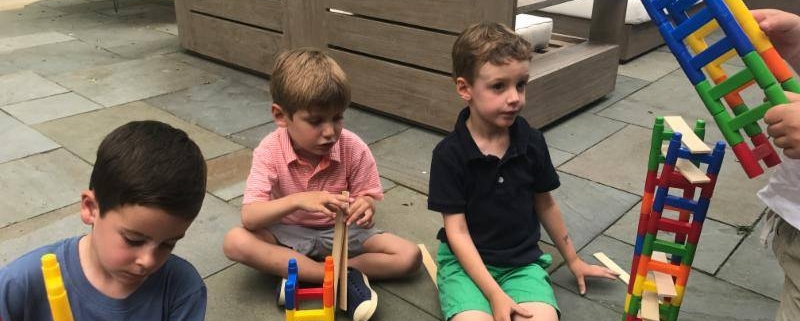4 Ways to Encourage Resilience in Children
Resilience — defined as “the capacity to overcome difficulty” — is an essential life skill.
And here’s what we know about resilience: the more adversity we encounter, the better we adapt to handling it.
Of course, it doesn’t come natural or easy for parents to allow their kids to experience discomfort. From the moment they’re born, we’re automatons geared toward stopping their little tears – whether it’s changing a wet diaper, warming up a bottle of milk, putting a Band-aid on a boo-boo, or refereeing a sibling disagreement.
Yet, we also see what happens when we’ve not given our kids a chance to work through setbacks on their own. Their fuses become shorter and shorter. Tears become the default – seemingly for attention – not the last resort. The most hurtful phrases come out of their tiny mouths: “I can’t do it!” or “I’m a failure!”
So how do parents allow their children the opportunity to learn from their mistakes and discover self-confidence, without clearing the way for their self-destruction? In this two-part series, we explore resilience-building tips for children that are tested, tried, and true.
Learn through dreaming.
Students are more motivated to succeed when they have a core purpose, according to research conducted by Dr. Carol Dweck and Dr. David Yeager at the University of Texas at Austin. Psychologists shared stories illustrating how school performance can impact the world and prompted students to write essays imagining how the world could be a better place. As students developed a belief they could achieve a purposeful life, their academic scores improved.
Similarly, you can help older children develop grit (passion and perseverance) by discussing purpose in life and the goals necessary to get there. Younger children can benefit from a dream board visualization tool – a poster board with photographs and printed or cut-out images from magazines illustrating passions, hopes, and goals.
Learn through storytelling.
Psychologist and author Maria Konnikova believes everyone can learn to become more resilient. It’s all in how we view adversity. She explains, “Frame adversity as a challenge and you become more flexible and able to deal with it, move on, learn from it, and grow.” On the other hand, if adversity is viewed as a threat, it can become a traumatic event that leads to inflexibility and negative outcomes.
Family narratives are a great way to “create meaning and provide perspective” on your child’s past, present, and future potential. Right before tucking them in at night can be a great moment for storytelling if the need doesn’t naturally arise during the day. “I noticed you were struggling with X earlier,” you might say. “Can I tell you about a time where something was really, really hard for me?” Kids love these personal stories and will often ask to hear them over and over, as a way of discovering something new about you — and about themselves. Choose stories that demonstrate challenge, illustrating how you tried to keep positive, didn’t give up, and benefited as a result of adversity. When times are tough and you feel frustrated, talk aloud to yourself to show your kids that life doesn’t come easy for you either, but you’re doing your best to cope with it and grow stronger. You may also teach using stories about famous people who used their passion and perseverance to reach long-term goals. Read about the lives of Michael Jordan, JK Rowling, Clara Barton, and others in The Failure Book: How 22 Extraordinary People Persisted and How You Can Too.
Learn through play.
Activities that involve focusing on the present moment or delaying gratification can be helpful exercises in resilience. In effect, the child learns, “I can’t always have what I really want right now, but I can still appreciate what I’m experiencing.” A five-year study conducted by the LEGO Foundation found that children of all ages and socioeconomic backgrounds benefit from learning through play – which supports emotional, physical, and intellectual capabilities. The inherent joy and stimulation of multiple brain networks while playing helps develop and maintain the social and emotional skills needed to deal with challenging and changing circumstances, researchers found.
Creativity and resilience are natural byproducts when parents or teachers and children play together. Children are better able to reduce complexity and imagine positive scenarios when working with others. If you’re not much of a LEGO or block builder, you can also try playing cooperative board games, which aids with impulse control, mental flexibility, turn-taking, and activation of the prefrontal cortex – the part of the brain involved in decision-making, emotional regulation, and resilience. Baduk or Go is one game scientifically proven to increase gray matter in the brain; kids as young as five can learn to play it.
Learn through sports and hobbies.
Activities that exercise the prefrontal cortex (the home of emotional regulation) and engage the hippocampus (where memories are stored) include: musical instrument lessons, mastering a sport (like soccer or tennis), and learning a new language. Interaction between these two key brain centers increases mental flexibility that comes in handy during problem-solving and decision-making. Children can begin this process at a very young age and spend years growing in their proficiency and developing their brains to function with greater efficiency.
In addition to getting your children involved in a few structured activities, you may also choose to share your own passions – which is not only a great bonding experience — but a path to fulfillment. It’s all too easy to lose some of your identity in the transformation to becoming “mom” or “dad,” but consider what interests have fallen by the wayside. It’s never too late to carve out time to rekindle that passion and invite a child to join in the fun with you – for the sake of everyone’s gray matter! In this way, you can model determination and encourage your child to do the same.
Become More Resilient by Letting Your Inner Light Shine!
We hope you’ve found these tips helpful. Stay tuned for Part II, where we explore more ways to build resilience in the New Year. In the meantime, we invite you to stop by the brand-new Shine Studio to explore the ways art can help children work through minor struggles and setbacks. We also host music lessons, sport camps, and language immersion, so be sure to ask about our full programming for 2022. Our educators are devoted to helping build resilience, confidence, and character in children from 6 months to 12 years.



